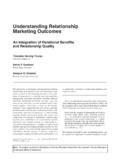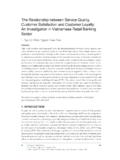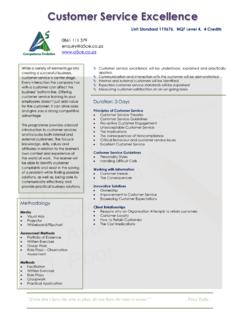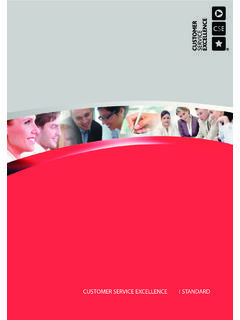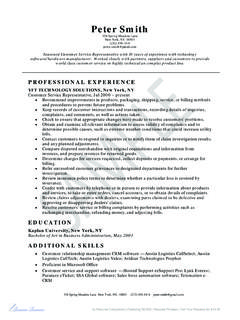Transcription of Customer-Employee Rapport in Service Relationships
1 JOURNAL OF Service . Gremler, RESEARCH. Gwinner / August / Customer-Employee . 2000 Rapport . Customer-Employee Rapport in Service Relationships Dwayne D. Gremler Bowling Green State University Kevin P. Gwinner Kansas State University Relationships are an important aspect of doing business, of the Service ( , Crosby, Evans, and Cowles 1990; File and few businesses can survive without establishing solid and Prince 1993; Jain, Pinson, and Malhotra 1987). How- Relationships with their customers. Although the market- ever, in spite of the attention that Customer-Employee rela- ing literature suggests that personal Relationships can be tionships have received, little has been done to identify important to Service firms, little specificity has been pro- which components or dimensions of these Relationships vided as to which relational aspects should receive atten- have the strongest impact on outcomes favorable to the tion. In this study, the authors examine one specific aspect firm ( , customer satisfaction, loyalty, etc.)
2 (cf. Barnes of Customer-Employee Relationships , Rapport , that they be- 1994). Indeed, Gummesson (1994) notes that it is .. ob- lieve may be particularly salient in Service businesses vious how much weight companies and consumers give to characterized by a high amount of interpersonal interac- Relationships and how little weight has been given to them tions. Rapport has received relatively little attention in the in the marketing literature (p. 16). Czepiel (1990) argues marketing literature; the goal of this study is to fill this gap that relational concepts are especially relevant to the mar- in the literature. In two different Service contexts, the au- keting of services because of their intangible nature, the thors find support for two empirically distinct dimensions extent to which the customer is involved in the production of Rapport . They also find a positive relationship between process, and the long-term formal and informal ties pro- these dimensions and satisfaction, loyalty intent, and viders often establish with their customers.
3 As interactions word-of-mouth communication. They conclude by sug- between employees and customers are repeated over time, gesting future research directions for further academic in- particularly as they work together to produce the Service quiry of Rapport in Service contexts. (Bowen 1986; Gummesson 1987), the motivation for the development of a social aspect to the relationship neces- sarily increases (Czepiel, Solomon, and Surprenant 1985). In fact, Gwinner, Gremler, and Bitner (1998) found that There have been frequent discussions in the marketing social benefits were rated by consumers as being more im- literature suggesting that personal Relationships can influ- portant than special treatment considerations as outcomes ence the evaluation of goods and services (Beatty et al. of engaging in relational exchanges with Service firms. 1996; Bitner, Booms, and Tetreault 1990). This is thought There are a variety of relational constructs that can be to be particularly true for services where a high amount of examined in assessing their potential to positively influ- Customer-Employee interaction is required in the delivery ence outcomes favorable to Service firms.
4 For example, We would like to acknowledge the helpful comments and suggestions provided by Scott Kelley (University of Kentucky) and the anonymous reviewers on earlier drafts of this manuscript. Journal of Service Research, Volume 3, No. 1, August 2000 82-104. 2000 Sage Publications, Inc. Gremler, Gwinner / Customer-Employee Rapport 83. Gremler and Brown (1998) identify five different factors vice provider employee, and (b) to be characterized by a comprising a higher order factor they call interpersonal personal connection between the interactants. We then ex- bonds: familiarity, care, friendship, Rapport , and trust. In amine these two dimensions of Rapport in two empirical this study, we examine one particular component of cus- studies (with bank customers and dental patients) and in- tomer-employee Relationships : Rapport . We choose to ex- vestigate how they relate to several outcomes (satisfaction, amine the Rapport construct for three reasons. First, loyalty intent, and word-of-mouth communication) im- although the marketing literature suggests that personal re- portant to Service firms.
5 Finally, we conclude by discussing lationships can be important to Service firms, little speci- implications from our findings, and we provide several di- ficity has been supplied as to which relational aspects rections for further academic inquiry. should receive attention. Therefore, in choosing to con- centrate on Rapport , we limit the scope of the broad con- struct of relationship marketing by focusing on one specific DIFFERING CONCEPTIONS OF Rapport . aspect of this construct. Second, Service exchanges can take many forms. Gutek et al. (1999) suggest that a Service rela- Scholars from many disciplines have investigated rap- tionship occurs when a customer has repeated interactions port. The construct has been examined in contexts as di- with the same provider, whereas, at the other end of their verse as educational settings, roommate Relationships , continuum, a Service encounter is a situation in which a psychotherapist-client interactions, qualitative data col- customer has a single interaction with a provider and has lection, and business transactions.
6 Table 1 provides a sum- no expectations of any future interactions. We believe that mary of various Rapport studies across several contexts. Rapport has the potential to be applicable across a variety of The table is organized according to context, provides defi- Service interactions regardless of whether the customer nitions of Rapport , and includes antecedents to and out- has repeated interactions with the same provider. Third, comes of Rapport . Rapport is such a familiar concept that we focus on Rapport because of its understudied nature in almost everyone can identify when it is present in a rela- marketing and its potentially large impact for Service tionship, yet pinning down a precise definition is not an firms. Although Rapport is likely to be applicable to a vari- easy task. Indeed, as shown by the diverse conceptualiza- ety of settings ( , business-to-business, personal sell- tions of Rapport in Table 1, Rapport has been considered dif- ing), we specifically consider Rapport in the context of ferently in a variety of studies.
7 Tickle-Degnen and Service exchanges because the intangible nature of many Rosenthal (1990) suggest that people experience Rapport Service encounters makes the Customer-Employee inter- when they click' with each other or [feel] the good inter- face particularly salient in customers' evaluations of the action [is] due to chemistry' (p. 286). Rapport has been Service (Bitner, Booms, and Tetreault 1990). When a described as the quality of the relationship in investigat- Service is difficult to evaluate, consumers often look to ing psychotherapist-client interactions (Gfeller, Lynn, and other cues, such as aspects of the interaction, in assessing Pribble 1987, p. 589), as the quality of [a] relationship Service quality (Parasuraman, Zeithaml, and Berry 1985). characterized by satisfactory communication and mutual Furthermore, due to the customer 's central position in ser- understanding in looking at college roommate relation- vice delivery and the simultaneous production-consump- ships (Carey et al.)
8 1988, p. 175), and as a quality in the re- tion aspects associated with many services , there is often lation or connection between interactants, especially an opportunity for Service employees to leverage Rapport relations marked by harmony, conformity, accord, and af- perceptions. Thus, perceptions of Rapport are important for finity (Bernieri et al. 1996, p. 113). However, as Service firms because they may help to positively influ- Tickle-Degnen and Rosenthal (1987) point out, despite ence judgments about the Service . its recognized importance to the outcome of interactions, The article is organized as follows: We begin this study the concept of Rapport has not been very clearly delin- of Rapport by reviewing the construct from a variety of lit- eated (p. 114). erature perspectives. To identify which components of Unfortunately, the marketing literature also lacks a Rapport are particularly important in a Service context, we clear delineation of the Rapport construct.
9 Although the conducted depth interviews of 41 respondents, including value of establishing Rapport with potential customers has both customers and employees. As we will discuss, our been recognized ( , Busch and Wilson 1976; Nickels, findings suggest that two Rapport dimensions are particu- Everett, and Klein 1983; Riordan, Oliver, and Donnelly larly salient in Service Relationships and help form the con- 1977; Spiro, Perreault, and Reynolds 1977; Weitz 1981;. ceptualization of Rapport used in this project; that is, based Weitz, Castleberry, and Tanner 1992; Woodside and Dav- on our analysis of the depth interviews and our review of enport 1974), few precise definitions or operationalizations the literature, we consider Rapport (a) to be the customer 's of the Rapport construct exist in this body of research. De- perception of having an enjoyable interaction with a ser- (text continues on p. 90). 84. TABLE 1. Studies of Rapport in Several Contexts Author(s) Context Description of Rapport Antecedents to Rapport Outcomes of Rapport Comments Education Bernieri (1988) interaction characterized as coordinated movement successful interactions Rapport measured by examining various characteristics of the interaction, high school teachers harmonious, smooth, in tune behavior matching by certain professions including enjoyment, liking of other, satisfaction, friendliness, interest, and students with, and on the same wave ( , psychotherapists, easygoing, cooperative, and humorous length (p.))
10 121) physicians, counselors, and teachers). LaFrance and sharing a common viewpoint mirroring found Rapport between class and instructor and posture sharing to be positively Broadbent (1976) posture sharing correlated college instructor listener attention and students environmental features LaFrance (1979) sharing a common viewpoint posture sharing found Rapport between class and instructor and posture sharing to be positively college instructor correlated and students Perkins et al. (1995) expressing an individual positive (student) in an experimental setting, Rapport was manipulated and found to influence college instructor interest in students' opinions evaluation of instructor students' ratings of instructors (in Study 2, 69% of the variance in the ratings and students and feelings and encouraging could be accounted for by variation in Rapport ). interaction between instructor suggest that instructors can establish Rapport even in large classes through and students developing Rapport with a single student Roommate Carey, Hamilton, and relationship characterized by purpose of study was to develop a reliable, unidimensional instrument to Shanklin (1986) satisfactory communication measure roommate Rapport ; started with Anderson and Anderson's (1962).

